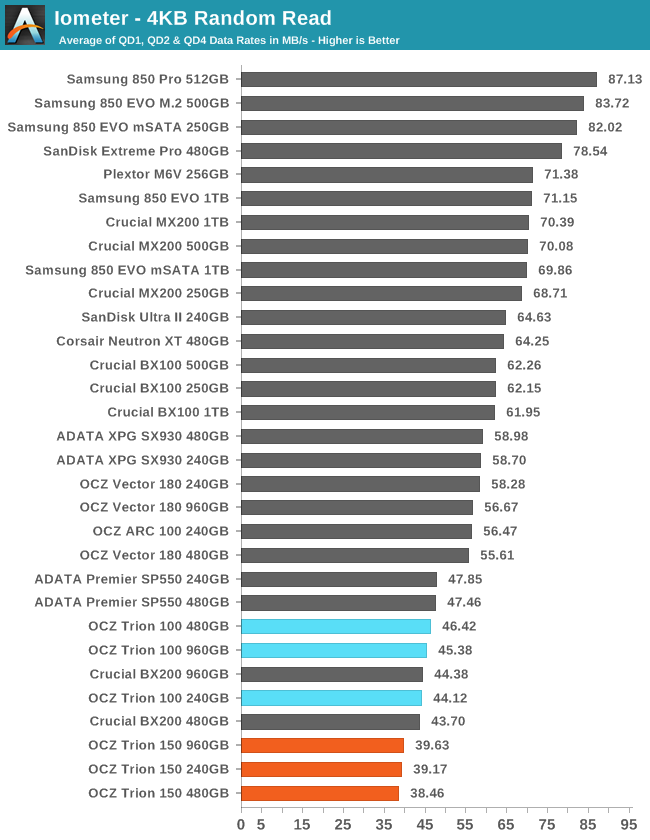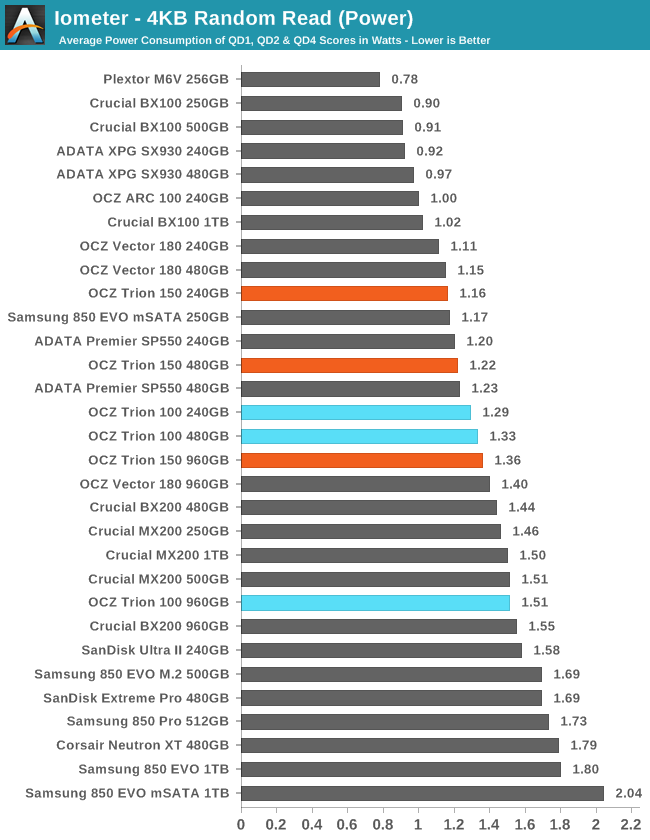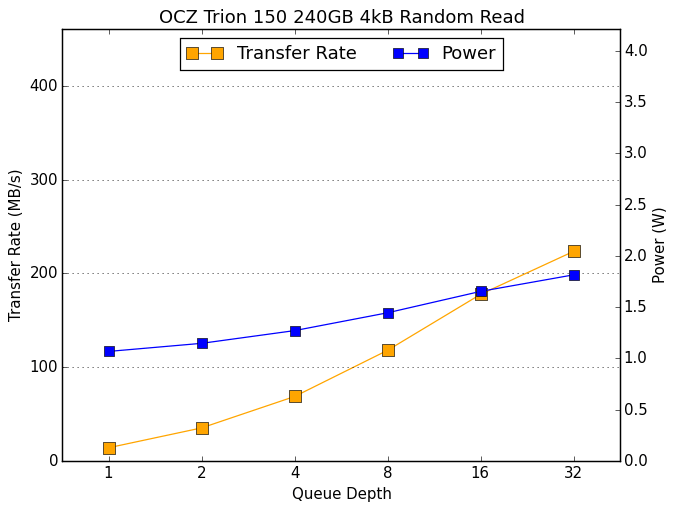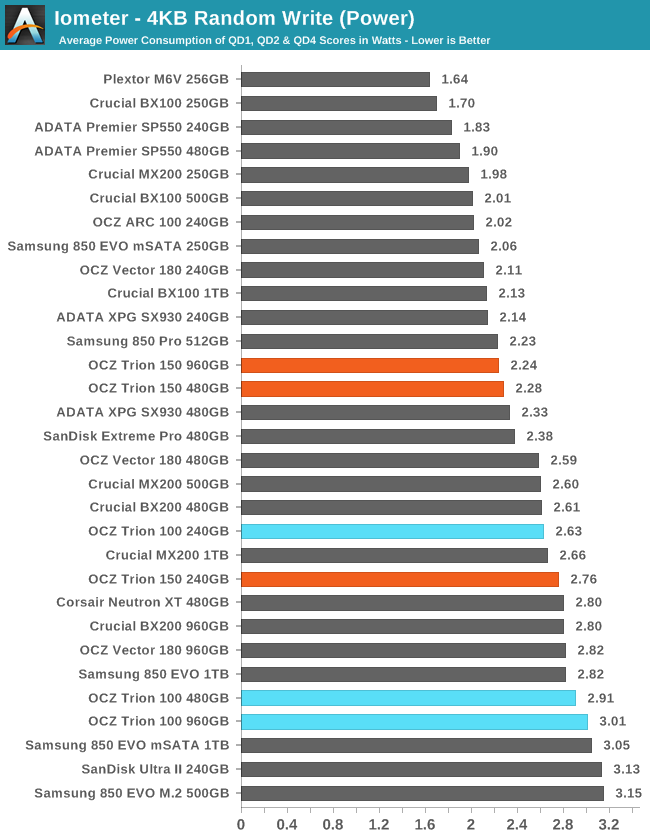The OCZ Trion 150 SSD Review
by Billy Tallis on April 1, 2016 8:00 AM ESTRandom Read Performance
The random read test requests 4kB blocks and tests queue depths ranging from 1 to 32. The queue depth is doubled every three minutes, for a total test duration of 18 minutes. The test spans the entire drive, which is filled before the test starts. The primary score we report is an average of performances at queue depths 1, 2 and 4, as client usage typically consists mostly of low queue depth operations.

The Trion 150 sets a new low for small queue depth random read speeds, with half the performance of the best SATA drives. This is probably the primary cause of the poorer latency scores seen on the ATSB tests. For context, the QD1 performance of the 480GB Trion 150 is still almost 50 times faster than a 7200RPM hard drive.

Power consumption has at least decreased in kind with the reduced performance, but the ADATA SP550 manages slightly better efficiency than the Trion 150 and most MLC drives are much more efficient.
 |
|||||||||
The 480GB Trion 150 doesn't perform quite as well at the highest queue depths as the other capacities, but all sizes perform considerably worse than the competition, especially at high queue depths.
Random Write Performance
The random write test writes 4kB blocks and tests queue depths ranging from 1 to 32. The queue depth is doubled every three minutes, for a total test duration of 18 minutes. The test is limited to a 16GB portion of the drive, and the drive is empty save for the 16GB test file. The primary score we report is an average of performances at queue depths 1, 2 and 4, as client usage typically consists mostly of low queue depth operations.

Random write speed on the 240GB Trion 150 got a huge boost over the Trion 100 and even the larger Trion 150s, but they all improved and widened the lead over SM2256 drives.

Power efficiency during random writes is much improved. The 240GB Trion 150 draws slightly more power than the 240GB Trion 100, but that's completely justified by the performance jump.
 |
|||||||||
The queue depth scaling behavior is quite odd. The 240GB Trion 150 doesn't change past QD4, but the larger sizes see a huge improvement moving to QD8 and beyond. This can make for some nice benchmark numbers but won't have much real-world impact. At low queue depths the 240GB comes out well ahead. This discrepancy is most likely a difference in the SLC caching configuration between the different models. Whatever the cause, the 240GB drive is making the better choices.










79 Comments
View All Comments
ummduh - Friday, April 1, 2016 - link
Ditto. Fool me once, shame on you. Fool me twice, not a chance.Murloc - Saturday, April 2, 2016 - link
yeah they could just kill the brand for anything SSD-related.NeonFlak - Friday, April 1, 2016 - link
The Mushkin Reactor not being included on any charts for SSD reviews must be a conspiracy, right? You guys did review it and it's in your best SSDs for 2016 list. Yet it doesn't appear to be included on the charts for any of the SSD reviews. Or am I just missing it?Billy Tallis - Friday, April 1, 2016 - link
It was reviewed with the 2014 test suite and I don't have the drive available to re-test with the current (2015) suite. The results from the Mushkin Reactor review may not be directly comparable to the current reviews, but indicate that it performs a little worse than the Crucial BX100 that has the same controller and flash.ghanz - Friday, April 1, 2016 - link
Hi Billy, will there be a future review on the Sandisk Plus which presumably uses SM2246XT & MLC NAND?It's the lowest tier in Sandisk's SSD lineup & is priced even lower than the TLC based Ultra II.
hojnikb - Friday, April 1, 2016 - link
+1 for that. Almost picked it up but went with a second hand 840pro instead.Samus - Sunday, April 3, 2016 - link
I actually had an 840 Pro that was 2 years old fail on me a few months ago. It was hell getting Samsung to warranty it. The process was awful. I've been using it lightly a few months, and I'd sell it if you want it. $90 bucks. It's a 256GB.vanilla_gorilla - Friday, April 1, 2016 - link
The people complaining about the drives performance need to consider that what's beating it cost significantly more. These are drives for low-mid range computers. And for 99% of your desktop use, if I swapped out your much more expensive (probably Samsung) SSD you'd probably never notice the difference in day to day use.Take a breath, have a little perspective, stop worrying about inconsequential (relative to the intended use) benchmarks and take a close look at the cost.
Arnulf - Friday, April 1, 2016 - link
Not really - this drive costs more and sometimes performs worse than its in-house competitor (Trion 100). The fact that it only reliably trumps BX200 is quite telling ...Tanclearas - Friday, April 1, 2016 - link
Take a look at the Mushkin Enhanced Reactor. Its results will be VERY close to the BX100. That drive outperforms (often by a large margin) the OCZ in nearly all benchmarks, and it costs the same. In fact, Newegg regularly has it on sale for $209.